Reduce, reuse, recycle, right? It’s as good for your profit margin as it is for the environment.
Creating new content is the most time-consuming marketing activity you can do. Sure, content is important, but a better use of your time is updating and repurposing your existing content.
Indeed, 61% of marketers say repurposing old content is their most efficient content marketing strategy, second only to search engine optimization (SEO), according to Semrush.
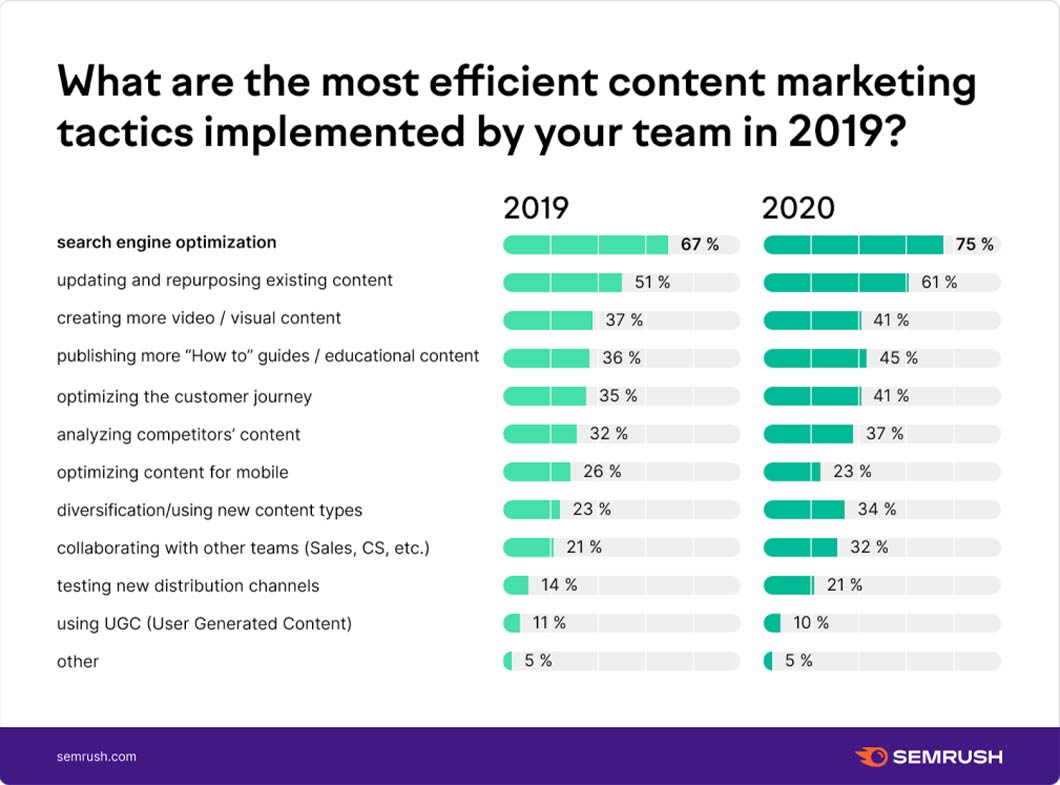
But how does repurposing content help you grow? We’ll cover all that as well as the best system for maximizing value from every piece of content.
What Is Repurposing Content? (And Why You Should Do It)
But first, what is repurposing content?
Repurposing content isn’t resharing an old blog post on social media. It also isn’t simply updating an old blog post with new information.
Those are both great things to do but they’re not repurposing.
Repurposing content means taking an existing piece of content and turning it into something new. You’re creating another standalone piece of content from something else.
Common examples are:
- Creating an infographic from statistics in an article.
- Turning a YouTube video interview into a podcast episode.
- Compiling a series of related blog posts on 1 topic into a guide or ebook.
The 3 major benefits of repurposing your content are:
1. New Format = New Audience
People respond differently to various content formats. Statista reports the most popular content types below, with how-to articles leading the pack.
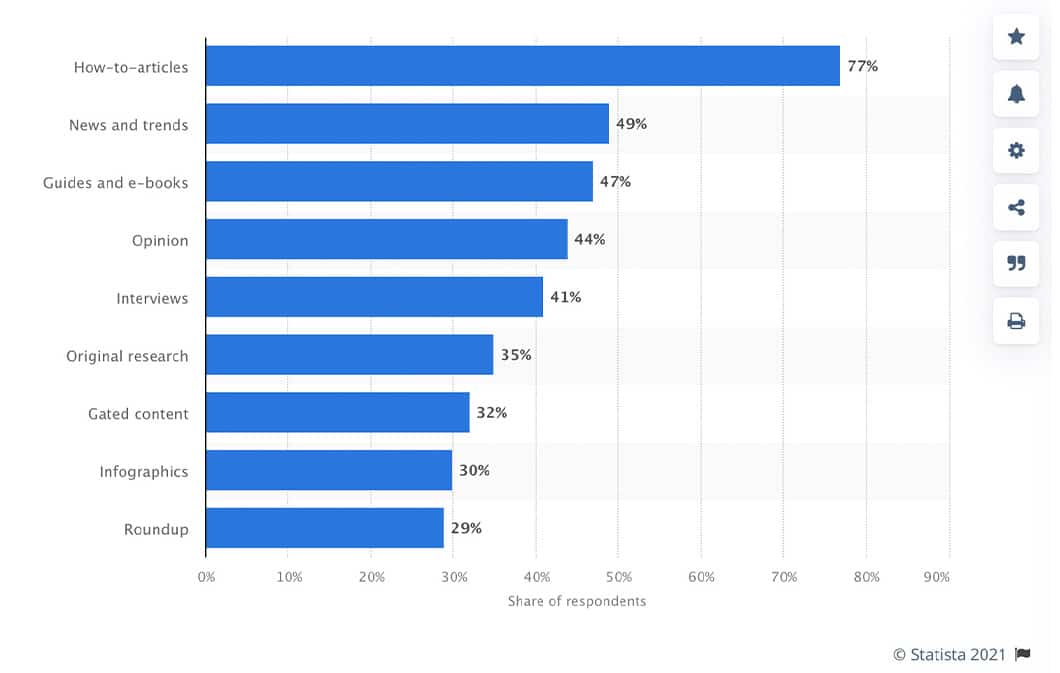
That survey was more about the message behind the content than the format, but it shows that what one person likes the most, another will like the least.
If you only have a podcast, but I hate podcasts, am I ever going to discover you? No, but if you summarize each episode in a blog post, I might enjoy reading it, become a fan and eventually be a customer.
By repurposing your content into various formats, you can attract a new audience who otherwise may not have stuck around or found your content at all — simply because of the format.
2. Saves Time
What’s a better use of your time? Writing a new blog post every day, then sharing it once to social media and hoping people find it?
Or, writing a new blog post each week, and spending time every day repurposing your existing content into new formats that you can share in more places to attract more people?
Repurposing content isn’t only more effective than pumping out new content daily, but it saves you time, too. Repurposing is always faster than creating something from scratch and easier to outsource, too. (More on that later.)
3. Great for SEO
Repurposing content is excellent for your organic search traffic because it does many things Google likes:
- Makes your website appear timely with frequent updates.
- Builds quality backlinks from content you share elsewhere, such as SlideShare or LinkedIn.
- Boosts your “social signals.” There has been a lot of debate on whether Google tracks how many social media shares and links direct back to your website. According to Search Engine Journal’s research, social media shares and links do have an effect on your SEO.
An experiment from Backlinko increased organic traffic by 118% to 1 repurposed blog article in only 3 months.
Top 10 Formats for Repurposing Your Content
Anything can be repurposed into something else. That line right there could be turned into a quote graphic for Twitter, linking back to this article, for example.
Here are 10 of the most popular content formats with examples of how to repurpose each one into new formats.
Blog articles are the easiest piece to start with because you could turn it into anything else on this list and it’s probably what you have the most of already.
1. Articles
- Turn the written content into an audio script for a podcast episode.
- Make it into a YouTube video.
- Create an infographic with any statistics or data from the article.
- Compile multiple blog posts on the same topic together into an ebook, and offer it as a lead magnet for subscribing to your email list.
In this example from G2, the company turned a blog post about dealing with negative reviews into this flowchart-style infographic.
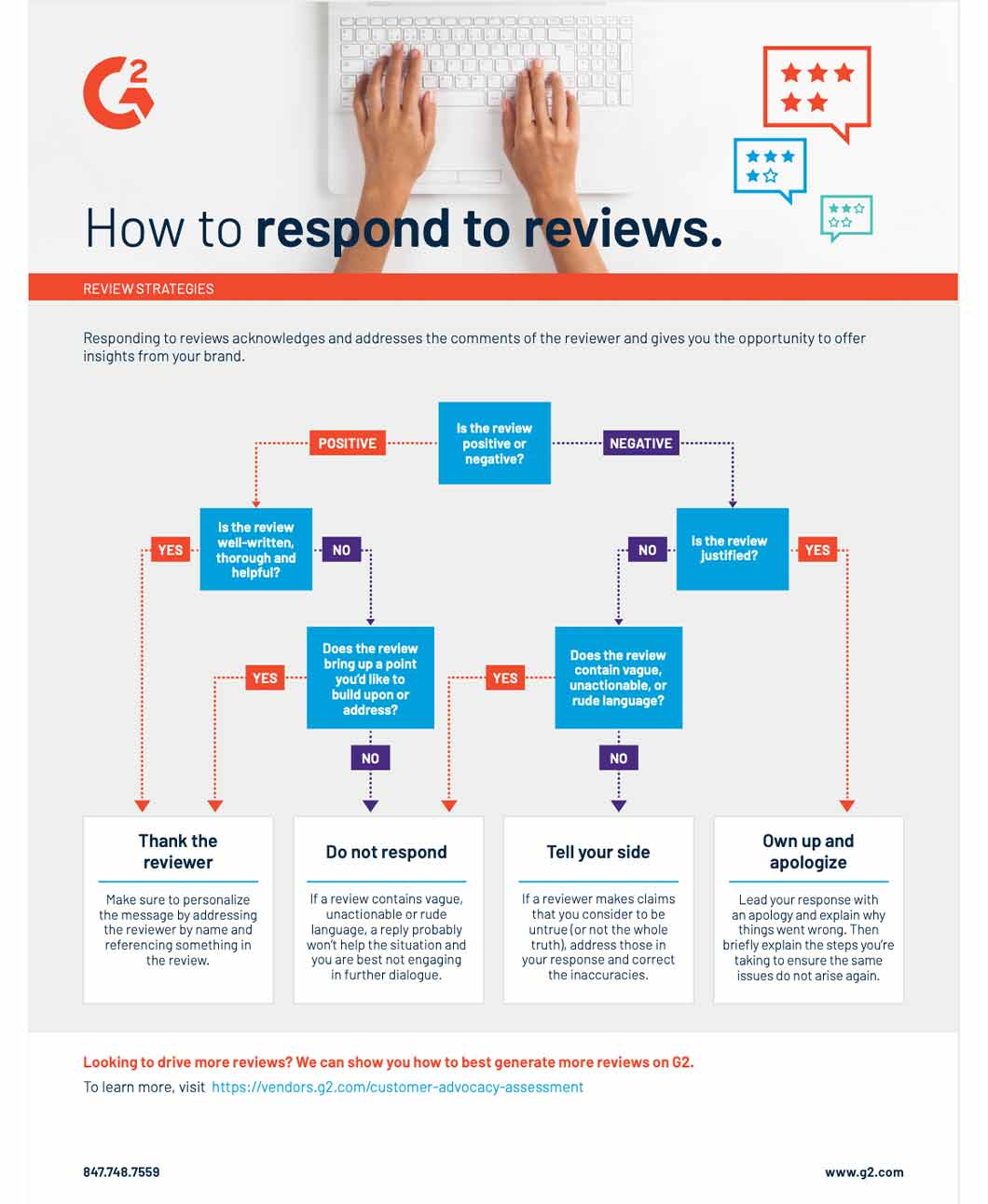
2. Videos
- Extract the audio as a podcast episode.
- Summarize the video’s key points in a blog post.
- Compile multiple videos to create an online course.
3. Podcasts
- Transcribe it into a blog post or dedicated section on your website.
- Take short snippets of your audio and combine with graphics to create Instagram Reels or Stories videos.
4. Infographics
- Pull out key statistics and list them in a blog post.
- Create mini infographics on 1 area to use on social media.
- Create a presentation from existing infographics and upload it to platforms such as LinkedIn and Slideshare.
5. Social Media Posts
- Use snippets from articles to create quote-based graphics.
- Take a list article and summarize up to 10 key points or items in graphics to use as Instagram content.
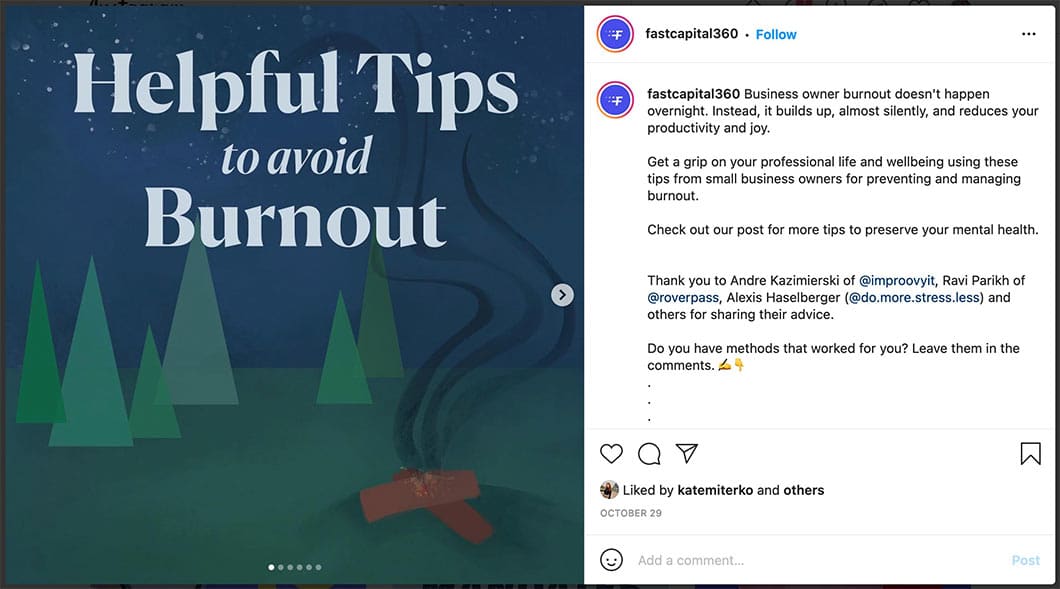
6. Case Studies
- Combine multiple existing case studies into an industry-targeted compilation, such as “5 Case Studies for Enterprise SaaS.”
- Create a landing page based around your case study’s results and offer the full file as a lead magnet.
7. White Papers
- Break down existing white papers into a series of blog posts or videos.
- Compile white papers into a longer format ebook to offer as a lead magnet or even sell on your website or Amazon.
8. Ebooks
- Break out the first chapter to offer for free as a lead magnet, then upsell to the full book.
- Create case studies from the examples in your ebook.
- Turn the ebook’s content into videos to create an online course, and revise the ebook to offer as a study guide for the course.
9. Presentations and Slideshows
- Expand on your presentation to turn it into a full ebook.
- Create social media graphics from pages of the presentation to use on visual platforms, such as Instagram.
- Create a blog post summarizing the presentation and link to it from SlideShare.
This Copyblogger presentation has more than 100,000 views on SlideShare. Talk about a traffic machine.
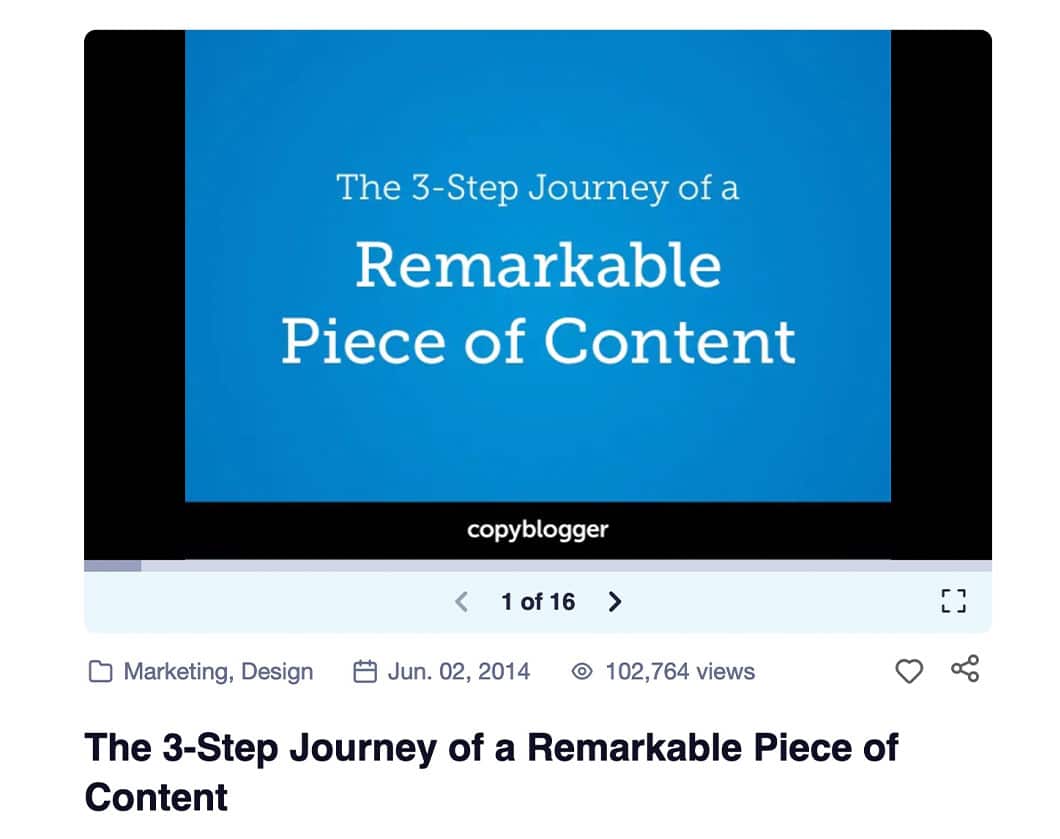
10. Online Course
- Combine all the content you have on a topic into an online course. There is likely a goldmine of information in your archive of blog posts. Turn that into videos and upload it as a course using a platform such as Teachable.
- Compile existing videos or articles to create an email-based course, where subscribers receive 1 piece of content per day for 3-5 days. It makes a great lead magnet.
How to Repurpose Content the Right Way
Start With Your Top Performing Content
What’s the first rule of content marketing? Give your audience what they want.
To maximize the effects of repurposing your content, start with your most popular blog posts or pages. You can find your top 10 pages on Google Analytics under Behavior -> Site Content -> All Pages.
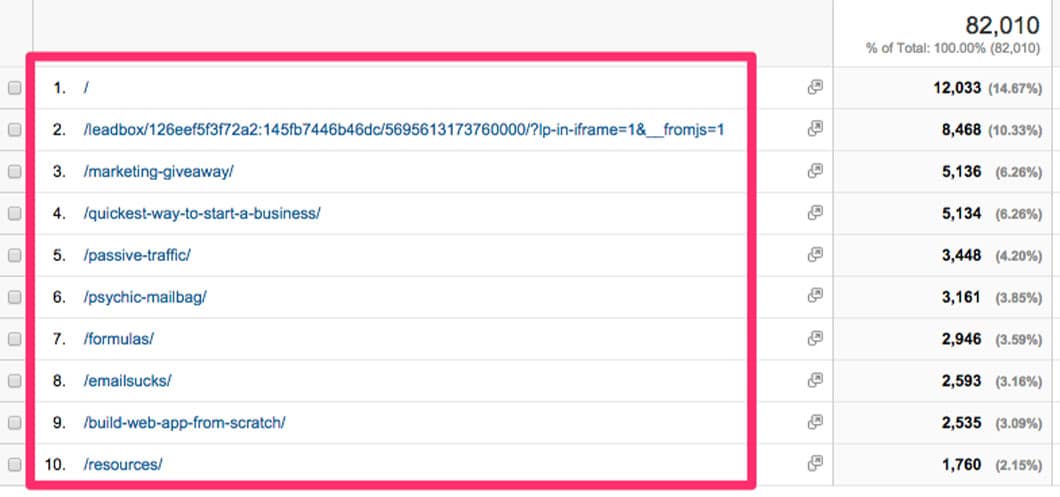
Repurpose your top 10 articles first. Use the list above for ideas on what to create from them.
Update the Original First
OK, you’ve got a list of blog posts to repurpose, now what? Before you jump in and start creating an infographic or video, you should review the existing content first.
Read it over and ask yourself:
- Is this still our brand voice and writing style?
- Are there any spelling or grammatical errors?
- Can I find some new data to replace information in this or add to it to make it more powerful and/or timely?
Updating on its own isn’t the same as repurposing but it’s important to do it regularly.
Google loves fresh content, so updating old articles will help boost your SEO. But even more importantly, your readers will find them more relevant if they include recent data.
Bonus tip: Add a feature to your blog that shows when an article was last updated. This quickly lets users know what they’re reading is up to date, which is especially important in fast-moving industries, such as technology or marketing.
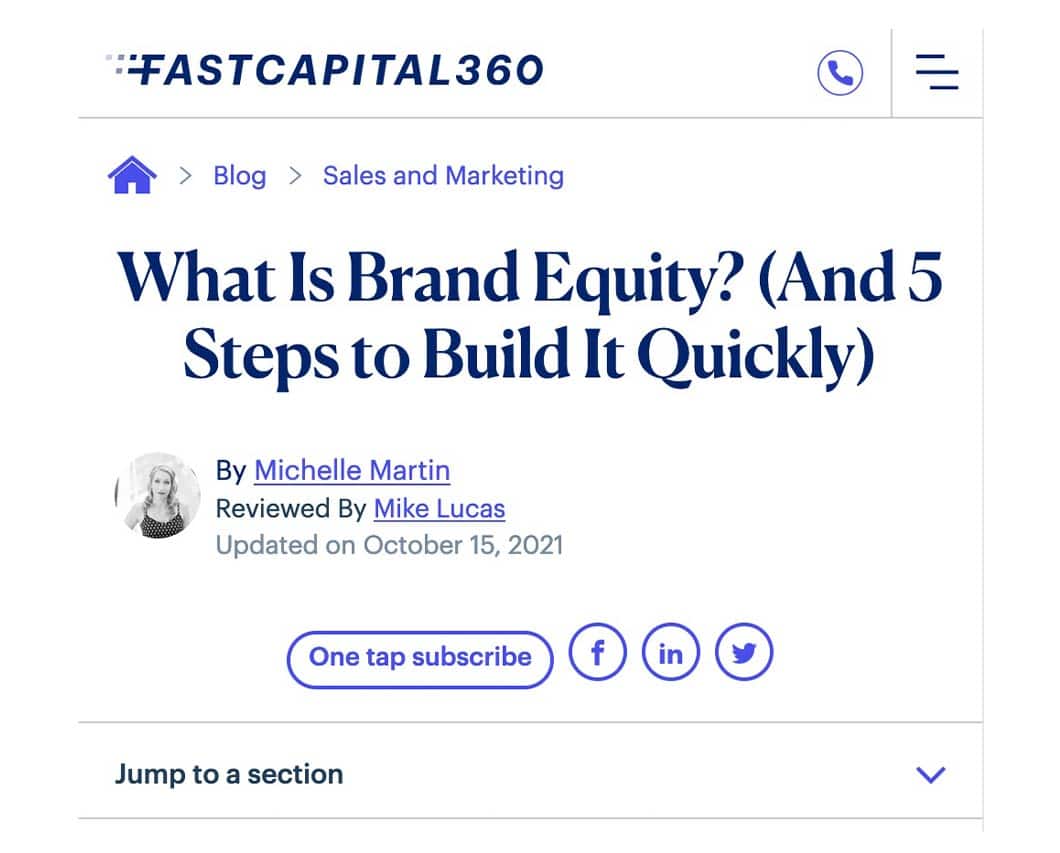
Repurpose Into Multiple Formats at the Same Time
Make a plan ahead of time to maximize your content repurposing time. List out all the different things you’re going to make out of your original content so you don’t miss any opportunities.
You’ll also stay organized as you distribute these tasks to your team, or outsource them.
For example, you can repurpose 1 blog article into:
- An infographic.
- A series of graphics for social media posts.
- A YouTube video.
- A podcast episode.
- An ebook (when combined with other articles).
- A SlideShare presentation.
- Part of an online course.
- A webinar topic.
You don’t need to create that much from each article, but ensure you have a plan before you start slicing and dicing content into new formats.
Need Help? Outsource It
Don’t have a marketing team or the exact specialty needed for a certain type of content? Outsourcing is your friend.
Outsourcing content repurposing long-term can be a highly profitable way of upping your content marketing game. If you have a marketing team, you free up their time to focus on new campaigns. If you don’t, then you free up your own time to focus on strategy and other business tasks. Plus, you can maximize the formats you produce because you can hire multiple outsource partners: a graphic designer, a podcast editor, a video editor and so on.
You can find freelancers on websites such as Fiverr, or go with a content marketing agency.
Repurpose Content to Work Smarter, Not Harder
Time is your most valuable asset so instead of stressing about new content ideas, get your existing content working for you instead.
The best part is your audience won’t know they’re seeing recycled content. Repurposing your content into new formats still provides value to your audience on topics they care about.
Plus, you’ll attract new leads, since people like to consume different types of content. It’s also a powerful way to boost your SEO.
Repurposing content should be a key pillar of your content marketing strategy and something you do right away when you create something new. Repurposing older, popular pieces also keeps them working their hardest for you.











